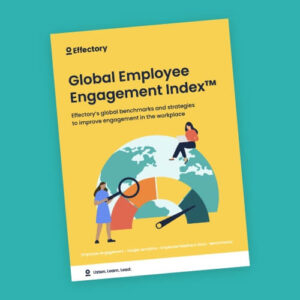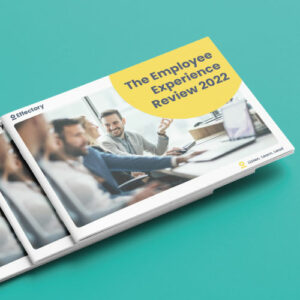Employee commitment can take different forms. As a result it is often seen as an HR variable which is difficult to define. The context, direction and development of commitment, as well as the extent to which commitment influences behaviour can result in confusion and debate.
What is employee commitment?

Here are some definitions of commitment in different contexts1:
- Connection to a goal: being bound to a goal or the determination in respect of a goal, regardless of the origin of the goal.2 Believing in a goal and wanting to achieve it also reflects a certain degree of commitment.
- Connection to an organisation: a psychological state that binds an individual to the organisation.3 As a result employees are more loyal to an organisation and less likely to leave it.
- Connection to a job: the probability that someone continues to work in that job and feels psychologically bound to it. This is regardless of whether it is fulfilling or not.4
- Someone’s attitude towards their work.5
com-mit-ted (adj.)
One bound or obligated to a particular, cause, action or attitude
Global Employee Engagement Index™
Discover the Global Employee Engagement Index™ 2025 for key insights on driving employee engagement, improving performance, and enhancing team dynamics.
DownloadWhat does commitment mean in business?
These definitions essentially have the same meaning, namely that commitment is a stabilising or binding force (mind-set), which directs behaviour.6 But what does commitment mean in business? In order to show how commitment to work can contribute to improving performance, we use the commitment of your employees towards your organisation. In other words, the bond with your organisation.
When working with multinational organisations, we use the following general definition:
Commitment is the bond employees experience with their organisation. Broadly speaking, employees who are committed to their organisation generally feel a connection with their organisation, feel that they fit in and, feel they understand the goals of the organisation. The added value of such employees is that they tend to be more determined in their work, show relatively high productivity and are more proactive in offering their support.
How does employee engagement differ from organisational commitment
At Effectory International, we’re often asked to explain the difference between engagement and employee commitment. Engagement is an intrinsic attitude that denotes an employee’s enthusiasm for his or her job. Commitment, on the other hand, denotes an employee’s enthusiasm for the company he or she works for.
In short:
- Engaged employees are engaged in their work, but not committed to the organisation.
- Committed employees are committed to the organisation, but not engaged in their work.
How to increase employee commitment
Download the Employee Experience Review
Discover how employees around the world are experiencing different parts of the employee journey and how this affects the employee experience.
DownloadTypes of employee commitment
The description above is a very good indicator of employee commitment, but does only offer a broad description. In their article “Three component model of commitment” John Meyer and Natalie Allen8 discuss commitment in great detail. We can see from their insightful research that there exists three distinct types of employee commitment:
1) Affective commitment
Affective commitment relates to how much employees want to stay at their organisation. If an employee is affectively committed to their organisation, it means that they want to stay at their organisation. They typically identify with the organisational goals, feel that they fit into the organisation and are satisfied with their work. Employees who are affectively committed feel valued, act as ambassadors for their organisation and are generally great assets for organisations.
2) Normative commitment
Normative commitment relates to how much employees feel they should stay at their organisation. Employees that are normatively committed generally feel that they should stay at their organisations. Normatively committed employees feel that leaving their organisation would have disastrous consequences, and feel a sense of guilt about the possibility of leaving.
Reasons for such guilt vary, but are often concerned with employees feeling that in leaving the organisation they would create a void in knowledge/skills, which would subsequently increase the pressure on their colleagues. Such feelings can, and do, negatively influence the performance of employees working in organisations.
3) Continuance commitment
“Do not hire a man who does your work for money, but him who does it for the love of it“
Continuance commitment relates to how much employees feel the need to stay at their organisation. In employees that are continuance committed, the underlying reason for their commitment lies in their need to stay with the organisation. Possible reasons for needing to stay with organisations vary, but the main reasons relate to a lack of work alternatives, and remuneration.
A good example of continuance commitment is when employees feel the need to stay with their organisation because their salary and fringe benefits won’t improve if they move to another organisation. Such examples can become an issue for organisations as employees that are continuance committed may become dissatisfied (and disengaged) with their work and yet, are unwilling to leave the organisation.
3 Key Types of Organisational Commitment
As the American author Henry David Thoreau advised more than 150 years ago:
“Do not hire a man who does your work for money, but him who does it for the love of it“
How to gather feedback from your employees
The definitive checklist for creating your employee engagement survey.
DownloadImportance of being comitted to work
In recent years commitment to work has garnered a lot of attention in HR literature. Information about employee commitment is seen as an important predictor of employee loyalty and the performance of an organisation.
The pressure on organisations to perform is increasing all the time. Due to globalisation, among others, competition is fiercer than ever. This increased pressure has resulted in the commitment of employers towards employees becoming less of a given. The concept of lifetime employment has also become outdated. These days, organisational units that perform badly are reorganised. As a rule this leads to job cuts. In addition, employees who perform badly are more likely to be let go.
Employee engagement and commitment by industry
As a result of this phenomenon, combined with people’s greatly increased individualism, employee commitment to work and the organisation has also become much less of a given. This makes it even more important that employees feel bound to the organisation and display certain (positive) behaviour.
Committed employees bring added value to the organisation, including through their determination, proactive support, relatively high productivity and an awareness of quality. Employees’ being comitted to work are also less likely to call in sick or to leave the organisation.9 Non-committed employees can work against the organisation and hold back the organisation’s success.
References:
- Meyer, J.P. and Herscovitch, L. (2001) Commitment in the Workplace: Toward a General Model. Human Resource Management Review, Vol. 11, 299-326
- Locke, et al (1988) The Determinants of Goal Commitment. Academy of Management Review, Vol. 13, 23-39
- Allen, N.J. and Meyer, J.P. (1990) The Measurement and Antecedents of Affective, Continuance and Normative Commitment to the Organization. Journal of Occupational Psychology, Vol. 63, 1-18
- Rusbult, C.E. and Farrell, D. (1983) A Longitudinal Test of the Investment Model: the Impact of Job Satisfaction, Job Commitment and Turnover Variations in Rewards, Costs, Alternatives and Investments. Journal of Applied Psychology, Vol. 69, 429-438
- Blau, G.J. (1985) The Measurement and Prediction of Career Commitment. Journal of Occupational Psychology, Vol. 58, 277-288
- Meyer, J.P., Vandenberghe, C. and Becker, T.E. (2004) Employee Commitment and Motivation: A Conceptual Analysis and Integrative Model. Journal of Applied Psychology, Vol. 89, 991-1007
- Meyer, J.P. and Herscovitch, L. (2001) Commitment in the Workplace: Toward a General Model. Human Resource Management Review, Vol. 11, 299-326
- Allen, N.J. and Meyer, J.P. (1990) The Measurement and Antecedents of Affective, Continuance and Normative Commitment to the Organization. Journal of Occupational Psychology, Vol. 63, 1-18
- Iles, P. et al (1990) HRM Practices and Employee Commitment: Possibilities, Pitfalls and Paradoxes. British Journal of Management, Vol. 1, 147-157
Book a free demo. See our solutions in action.
Effectory is Europe’s Leading provider of Employee Listening Solutions. Schedule a product demo and discover how to enhance your employees’ engagement.
Demo request


